Camera Lens Tutorial
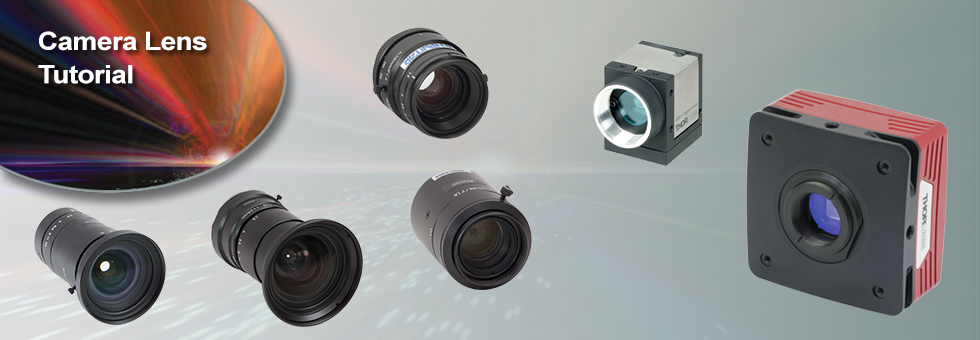

Please Wait
Aperture
The aperture of the lens controls the amount of light that a lens can collect; the more light a lens collects, the brighter the image. Because of this, the aperture size affects the exposure time and therefore the speed of the camera. Thorlabs provides the maximum aperture size in the tables below for each lens in terms of the f-number, which is expressed using the symbol f/# (e.g., f/1.4). As the f-number increases, the aperture opening becomes smaller and less light is collected by the lens.
Specifically, f-number is defined as:
where f/# is the f-number, f is the focal length and d is the entrance pupil diameter.
Camera lenses that can collect a lot of light (i.e., a low f-number) are known as fast lenses as they can be used with shorter exposure times and are ideal for low-light conditions. For example, a 50 mm focal length lens with a f/1.4 aperture has a bigger aperture and is therefore faster than a lens at the same focal length with a f/2.5 aperture. While using larger apertures increases light collection, doing so reduces the axial in-focus region of the image, known as the depth of field. To illustrate the effect of different aperture sizes visually, the table below shows a sequence of images taken with the same lens (MVL12M43 on a DCU224C 1/2" format camera) for increasing f-numbers. Because the images were taken at constant exposure, for each f/# increase (by a factor of ~1.4) the amount of light collected by the lens is reduced by half.
| Aperture Size Effects (Click Photos to Enlarge) | ||||||
|---|---|---|---|---|---|---|
| f/2 | f/2.8 | f/4 | f/5.6 | f/8 | f/11 | f/22 |
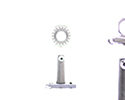 |
 |
 |
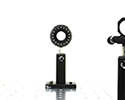 |
 |
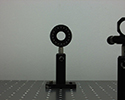 |
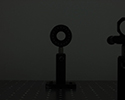 |
| Click for Raw Image | Click for Raw Image | Click for Raw Image | Click for Raw Image | Click for Raw Image | Click for Raw Image | Click for Raw Image |
Focal Length
The focal length (FL) is roughly defined as the distance from principal plane to the focal plane. For a camera lens, the focal length determines the field of view of the camera system; the longer the focal length, the smaller the field of view. As a general guideline, a 50 mm focal length lens and 35 mm format camera combination produces roughly the same field of view as the human eye (~53° diagonal). The table below lists the focal lengths needed to achieve the same field of view as the human eye for different sensor formats.
There are three general classifications for lenses related to the image field of view. A lens with a focal length close to the diagonal length of the sensor format produces an image with a near-human field of view and is considered a "normal" lens for that sensor format. A wide-angle lens has a focal length shorter than normal, which produces a wider field of view but has a tendency to exhibit barrel distortion effects towards the edge of the image. Finally, a lens with a focal length longer than normal is known as a telephoto lens, which has a smaller field of view and a greater magnification of objects in the image.
DCU224C 1/2" Format CCD Camera
To illustrate this, the sequence of three images to the right were taken with the same camera with three different lenses. As focal length of the lens increases, magnification of the objects in the photos increases while the field of view decreases. The items in the image are each roughly spaced in 10" (254 mm) increments in the following order: Polaris™ Fixed Monolithic Mirror Mount (10" from camera), Ø1/2" post with KM100 mirror mount (20" from camera), and post-mounted RSP1 rotation mount (30" from camera). The MVL4WA used to shoot the first image is a wide angle lens which clearly distorts the door frame on the left edge of the image.
| Sensor/Lens Combinations for Human Eye Field of View | |
|---|---|
| Sensor Format | Lens Focal Length |
| 1/3" (6 mm Diagonal) | 6.9 mm |
| 1/2.9" (6.2 mm Diagonal) | 7.1 mm |
| 1/2" (8 mm Diagonal) | 9.2 mm |
| 1/1.8" (9 mm Diagonal) | 10.4 mm |
| 2/3" (11 mm Diagonal) | 12.7 mm |
| 1/1.2" (13.3 mm Diagonal) | 15.3 mm |
| 1" (16 mm Diagonal) | 18.5 mm |
| 4/3" (23 mm Diagonal) | 26.6 mm |
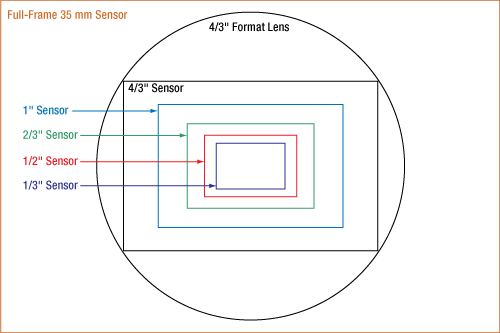
| Crop Factors for Different Sensor/Lens Combinationsa | ||||||||
|---|---|---|---|---|---|---|---|---|
| Sensor Format | Lens Design Format | |||||||
| 1/3" | 1/2.9" | 1/2" | 1/1.8" | 2/3" | 1/1.2" | 1" | 4/3" | |
| 1/3" (6 mm Diagonal) | 1 | 1.03 | 1.33 | 1.50 | 1.83 | 2.22 | 2.67 | 3.83 |
| 1/2.9 (6.2 mm Diagonal) | - | 1 | 1.29 | 1.45 | 1.77 | 2.14 | 2.58 | 3.71 |
| 1/2" (8 mm Diagonal) | - | - | 1 | 1.13 | 1.38 | 1.66 | 2.00 | 2.88 |
| 1/1.8" (9 mm Diagonal) | - | - | - | 1 | 1.22 | 1.48 | 1.78 | 2.56 |
| 2/3" (11 mm Diagonal) | - | - | - | - | 1 | 1.21 | 1.45 | 2.09 |
| 1/1.2" (13.3 mm Diagonal) | - | - | - | - | - | 1 | 1.2 | 1.73 |
| 1" (16 mm Diagonal) | - | - | - | - | - | - | 1 | 1.44 |
| 4/3" (23 mm Diagonal) | - | - | - | - | - | - | - | 1 |
Combining Different Camera Sensor and Lens Formats
Modern cameras that use CCD or CMOS sensors are specified for a camera sensor format, and similarly, lenses are designed to provide optimal imaging for a specific camera format. This format designation (e.g., 1/2", 2/3", 4/3") is a hold-over convention from when video was recorded using cathode-ray tubes and refers to the outer diameter of the video tube required for a given image size. The diagram to the right illustrates the size difference between several standard camera formats. In the ideal imaging system, a camera and lens would be designed for the same format, however, it is also possible to use camera/lens combinations with different formats. Doing this will have an effect, either vignetting or cropping, on the resulting image.
Vignetting
Vignetting occurs when the lens format is smaller than the camera format. When this occurs, the area of the sensor is incompletely exposed, causing a dark ring to appear around the borders of the image. The vignetting effect is illustrated in the two images below, which were both captured using the same 4/3" format camera. In the image to the left, using a 12 mm focal length, 4/3" format lens produces a full image with slight dimming around the edges. This minor example of vignetting is due to the lens design which has decreased transmission at the edge of the lens. On the other hand, a 2/3" format lens at the same focal length produces a prominent dark ring around the photo edge. As the latter example is very visually apparent, we do not recommend using lenses with smaller formats than the camera sensor for imaging.
Vignetting: 8051M-GE 4/3" Format Camera
| Adjusted Focal Length (AFL) for Various Sensor Formatsa | ||||||||
|---|---|---|---|---|---|---|---|---|
| Item # | 1/3" | 1/2.9" | 1/2" | 1/1.8" | 2/3" | 1/1.2" | 1" | 4/3" |
| MVL4WA | 4.6 mm | 4.5 mm | 3.5 mm | - | - | - | - | - |
| MVL5WA | 5.9 mm | 5.8 mm | 4.5 mm | - | - | - | - | - |
| MVL5M23 | 9.2 mm | 8.8 mm | 6.9 mm | 6.1 mm | 5 mm | - | - | - |
| MVL5TM23 | 9.2 mm | 8.8 mm | 6.9 mm | 6.1 mm | 5 mm | - | - | - |
| MVL6WA | 7.8 mm | 7.7 mm | 6 mm | - | - | - | - | - |
| MVL8M23 | 14.6 mm | 14.2 mm | 11 mm | 9.8 mm | 8 mm | - | - | - |
| MVL8M1 | 21.4 mm | 20.6 mm | 16 mm | 14.2 mm | 11.6 mm | 9.6 mm | 8 mm | - |
| MVL12WA | 15.6 mm | 15.5 mm | 12 mm | - | - | - | - | - |
| MVL12M23 | 22 mm | 21.2 mm | 16.5 mm | 14.6 mm | 12 mm | - | - | - |
| MVL12M1 | 32 mm | 31.0 mm | 24 mm | 21.4 mm | 17.4 mm | 14.4 mm | 12 mm | - |
| MVL12M43 | 46 mm | 44.5 mm | 34.6 mm | 30.7 mm | 25.1 mm | 20.8 mm | 17.3 mm | 12 mm |
| MVL16M23 | 29.3 mm | 28.3 mm | 22 mm | 19.5 mm | 16 mm | - | - | - |
| MVL16M1 | 42.7 mm | 41.3 mm | 32 mm | 28.5 mm | 23.2 mm | 19.2 mm | 16 mm | - |
| MVL17HS | 45.4 mm | 43.9 mm | 34 mm | 30.3 mm | 24.7 mm | 20.4 mm | 17 mm | - |
| MVL25M23 | 45.8 mm | 44.2 mm | 34.4 mm | 30.5 mm | 25 mm | - | - | - |
| MVL25TM23 | 45.8 mm | 44.2 mm | 34.4 mm | 30.5 mm | 25 mm | - | - | - |
| MVL25HS | 66.8 mm | 64.5 mm | 50 mm | 44.5 mm | 36.3 mm | 30 mm | 25 mm | - |
| MVL25M1 | 66.8 mm | 64.5 mm | 50 mm | 44.5 mm | 36.3 mm | 30 mm | 25 mm | - |
| MVL25M43 | 95.8 mm | 92.8 mm | 72 mm | 64 mm | 52.3 mm | 43.3 mm | 36 mm | 25 mm |
| MVL35M23 | 64.1 mm | 62.0 mm | 48.1 mm | 42.7 mm | 35 mm | - | - | - |
| MVL35M1 | 93.5 mm | 90.3 mm | 70 mm | 62.3 mm | 50.8 mm | 42 mm | 35 mm | - |
| MVL50M23 | 91.5 mm | 88.5 mm | 68.8 mm | 61 mm | 50 mm | - | - | - |
| MVL50TM23 | 91.5 mm | 88.5 mm | 68.8 mm | 61 mm | 50 mm | - | - | - |
| MVL50HS | 133.5 mm | 129.0 mm | 100 mm | 89 mm | 72.5 mm | 60 mm | 50 mm | - |
| MVL50M1 | 133.5 mm | 129.0 mm | 100 mm | 89 mm | 72.5 mm | 60 mm | 50 mm | - |
| MVL75M23 | 137.3 mm | 132.8 mm | 103.1 mm | 91.5 mm | 75 mm | - | - | - |
| MVL75M1 | 200.3 mm | 193.5 mm | 150 mm | 133.5 mm | 108.8 mm | 90 mm | 75 mm | - |
| MVL100M23 | 183 mm | 177 mm | 138 mm | 122 mm | 100 mm | - | - | - |
Cropping
When the lens format is larger than the camera format, the effect on the resultant image is known as cropping. In this case, a full image is produced but at a smaller size (i.e. cropped) because the sensor is only capturing a fraction of the complete image. A crop factor or focal length multiplier quantifies the amount of cropping and is defined as the ratio of the diagonal length of the lens' design format divided by the diagonal length of the sensor format. The crop factor for all possible 1/3", 1/2.9", 1/2", 1/1.8", 2/3", 1", and 4/3" format lens/sensor combinations are shown in the table to the right.
An image that is cropped appears as if it was taken with a lens of higher focal length (i.e. a smaller field of view), but does not magnify the image. The cropping effect can be quantified using an adjusted focal length (defined as the crop factor multiplied by the lens focal length). For example, an image taken using a 1" format, 50 mm focal length lens with a 1/2" format sensor will produce an image with an adjusted focal length of 100 mm. While the field of view is reduced as if using a 100 mm lens, objects in the image will remain at the same size. The table to the right lists all of the lenses offered on this page with the adjusted focal length for different sensor formats.
The images below illustrate this effect visually using two images taken using the same lens with 1/2" and 1/3" format cameras. The image taken using the smaller 1/3" format camera produces an image that is cropped compared to the image taken using the 1/2" format camera. Note, however, that the objects in both images remain at the same magnification.
Cropping: MVL8M1 8 mm FL, 1" Format Lens
AFL = 21.4 mm
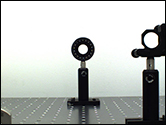
Click to Enlarge
Click Here for Raw Image (1024 x 768)
Thorlabs' Camera Lenses for Machine Vision each have a characteristic range of object distances. Objects placed within this range can be brought to a sharp focus on the sensor of the C-Mount camera. As seen in the image sequence below, the addition of an C-mount extension tube or spacer between the camera and the lens changes this range of object distances and allows the system to focus on objects closer to the lens. This increases the magnification of the image on the camera while decreasing the depth of field. The following table lists the range of possible object distances for various combinations of Thorlabs' C-Mount extension tubes and machine vision lenses.
Note that Thorlabs' camera lenses are designed to correct for optical aberrations witin a specified range of object distances. The modification of the specified minimum object distance with an extension tube may reduce the ability of these lenses to eliminate aberrations.
20 mm (15 mm + 5 mm) Spacer
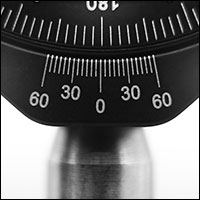
Click to Enlarge
Click Here for Raw (2048 x 2048) Image
RSP1X15 rotation mount imaged using a previous-generation scientific camera (Item # 4070M-GE) and MVL25M43 Lens at different object distances. A 20 mm spacer was created by using CML05 and CML15 spacers together.
| Object Distance and Magnification for Lens and Spacer Combinations | ||||||||||||
|---|---|---|---|---|---|---|---|---|---|---|---|---|
| Camera Lens | Focal Length | Design Format | No Spacer | 1 mm Spacer (CMSP100) | 5 mm Spacer (CML05) | 10 mm Spacer (CML10) | 20 mm Spacer (CML05 with CML15) | |||||
| Minimum Object Distance | Magnification | Minimum Object Distance | Magnification | Minimum Object Distance | Magnification | Minimum Object Distance | Magnification | Minimum Object Distance | Magnification | |||
| MVL8M23 | 8 mm | 2/3" | 120 mm | 0.07 | 30 mm | 0.2 | - | - | - | - | - | - |
| MVL12M23 | 12 mm | 2/3" | 150 mm | 0.08 | 70 mm | 0.16 | - | - | - | - | - | - |
| MVL12M1 | 12 mm | 1" | 300 mm | 0.04 | 93 mm | 0.12 | - | - | - | - | - | - |
| MVL12M43 | 12 mm | 4/3" | 100 mm | 0.1 | 48 mm | 0.19 | - | - | - | - | - | - |
| MVL16M23 | 16 mm | 2/3" | 200 mm | 0.08 | 110 mm | 0.14 | - | - | - | - | - | - |
| MVL16M1 | 16 mm | 1" | 300 mm | 0.05 | 134 mm | 0.11 | - | - | - | - | - | - |
| MVL25M23 | 25 mm | 2/3" | 200 mm | 0.12 | 150 mm | 0.16 | 73 mm | 0.31 | - | - | - | - |
| MVL25TM23 | 25 mm | 2/3" | 100 mm | 0.24 | 79 mm | 0.28 | 46 mm | 0.44 | 29 mm | 0.63 | - | - |
| MVL25M1 | 25 mm | 1" | 300 mm | 0.08 | 200 mm | 0.12 | 83 mm | 0.28 | - | - | - | - |
| MVL25M43 | 25 mm | 4/3" | 150 mm | 0.15 | 115 mm | 0.19 | 56 mm | 0.35 | 31 mm | 0.55 | 12 mm | 0.96 |
| MVL35M23 | 35 mm | 2/3" | 200 mm | 0.18 | 175 mm | 0.21 | 115 mm | 0.32 | 81 mm | 0.46 | 51 mm | 0.73 |
| MVL35M1 | 35 mm | 1" | 300 mm | 0.12 | 243 mm | 0.15 | 138 mm | 0.26 | 91 mm | 0.4 | - | - |
| MVL50M23 | 50 mm | 2/3" | 200 mm | 0.3 | 190 mm | 0.32 | 160 mm | 0.39 | 135 mm | 0.48 | 105 mm | 0.65 |
| MVL50TM23 | 50 mm | 2/3" | 100 mm | 0.46 | 91 mm | 0.48 | 76 mm | 0.58 | 64 mm | 0.7 | 49 mm | 0.94 |
| MVL50M1 | 50 mm | 1" | 500 mm | 0.11 | 424 mm | 0.13 | 269 mm | 0.2 | 189 mm | 0.3 | 124 mm | 0.5 |
| MVL75M1 | 75 mm | 1" | 1000 mm | 0.078 | 858 mm | 0.091 | 553 mm | 0.14 | 389 mm | 0.21 | 251 mm | 0.34 |
| MVL75M23 | 75 mm | 2/3" | 1200 mm | 0.07 | 1010 mm | 0.08 | 630 mm | 0.13 | 440 mm | 0.2 | 285 mm | 0.34 |
| MVL100M23 | 100 mm | 2/3" | 2000 mm | 0.05 | 1700 mm | 0.06 | 1060 mm | 0.1 | 740 mm | 0.15 | 480 mm | 0.25 |
 Products Home
Products Home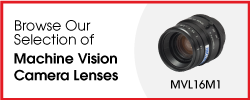
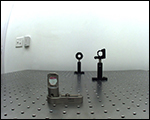
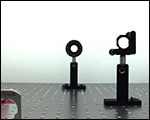
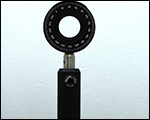
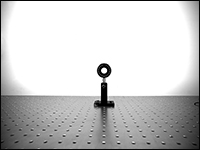
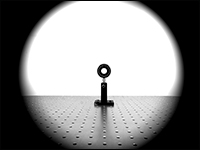
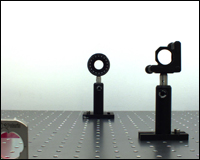
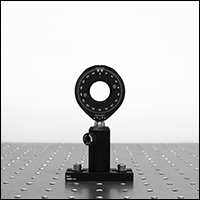
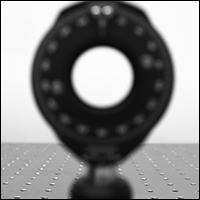
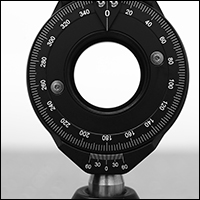
 Camera Lenses
Camera Lenses